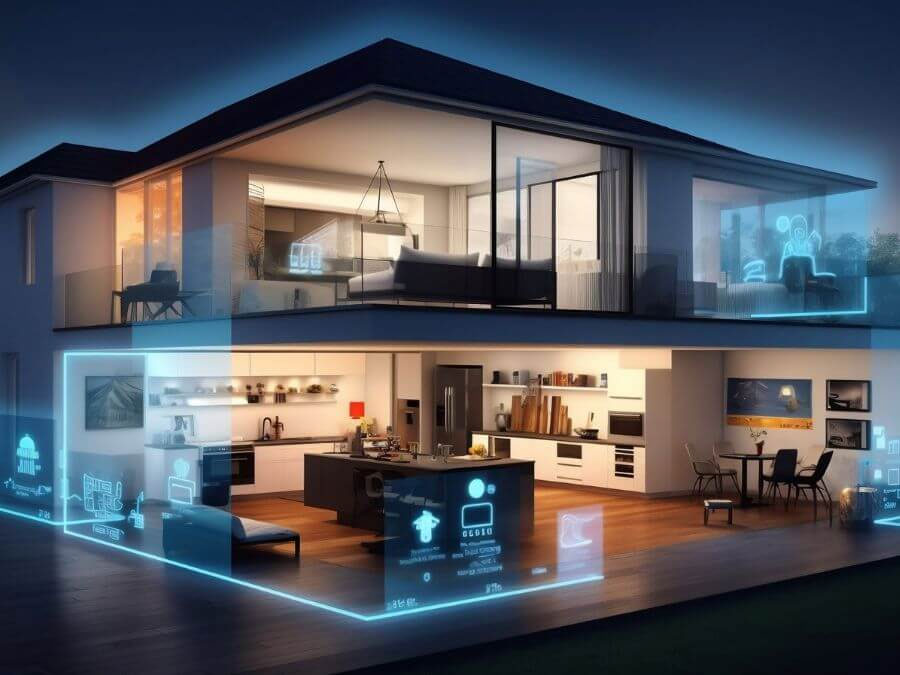Imagine walking into your home, and with a simple voice command, the lights adjust to your preference, the thermostat sets itself to the perfect temperature, and your favorite music begins to play. Welcome to the world of smart homes—where comfort, convenience, and energy efficiency converge. But behind the seamless operation of a smart home lies a robust and thoughtfully designed electrical system that serves as the foundation for all connected technology.
This blog explores how to integrate advanced electrical systems into your living space, transforming it into a smart home that enhances your lifestyle while adding value and security.
What Is a Smart Home?
A smart home uses internet-connected devices to enable the remote management of systems and appliances. These can include:
- Lighting
- Heating and cooling (HVAC)
- Security systems
- Appliances
- Entertainment systems
- Door locks and garage doors
- Irrigation and more
Integration of these systems allows homeowners to automate tasks, monitor energy usage, and control their environment from smartphones, tablets, or voice assistants.

The Electrical Backbone of Smart Homes
While the gadgets and apps get most of the attention, it’s the electrical infrastructure that powers and connects everything. Here’s how to prepare your home:
1. Upgrading the Electrical Panel
Smart homes often demand more power. Upgrading your electrical panel to handle increased loads ensures reliable operation of all connected devices.
2. Dedicated Circuits
Key smart devices (e.g., smart ovens, EV chargers) may require dedicated circuits to operate efficiently without interference or overload.
3. Whole-Home Surge Protection
Protect sensitive smart devices from power surges caused by lightning or grid issues. Whole-home surge protectors safeguard your investments.
4. Structured Wiring Systems
A structured wiring system centralizes data, audio/video, and security wiring, making future upgrades easier and reducing clutter.
Essential Smart Home Electrical Components
To fully embrace smart living, consider these core components:
1. Smart Lighting
- Features: Dimming, color control, scheduling, and voice control.
- Setup: Smart switches or smart bulbs, often requiring neutral wires and compatible wall boxes.
2. Smart Thermostats
- Features: Remote temperature control, learning schedules, energy reports.
- Installation: Requires C-wire for constant power and stable Wi-Fi connection.
3. Smart Outlets and Plugs
- Features: Control devices remotely, monitor energy usage.
- Installation: Can be plug-in or hardwired; hardwired versions require professional installation.
4. Smart Panels and Circuit Breakers
- Features: Monitor energy usage per circuit, control circuits remotely.
- Benefit: Enhanced control, real-time fault detection, energy optimization.
5. Security and Surveillance Systems
- Devices: Smart cameras, doorbells, motion sensors.
- Power Needs: Wired options require stable power sources and may need Power over Ethernet (PoE) setups.
Wi-Fi and Network Considerations
Reliable connectivity is key for a smart home. Consider these upgrades:
- Mesh Wi-Fi Systems: Provide consistent coverage across large homes.
- Wired Ethernet Connections: For bandwidth-heavy devices like security cameras or streaming hubs.
- Central Hubs: Smart home hubs (e.g., SmartThings, Apple HomeKit) unify devices under one control system.
Planning for a Smart Future
Even if you’re not ready to fully automate your home, future-proofing during renovations or new builds is smart:
- Install Extra Conduits: Allows easy addition of wiring later.
- Add USB Outlets: Convenient charging for devices.
- Consider Battery Backup Systems: Keeps critical systems operational during outages.
Real-Life Integration: Elevating Daily Living
Scenario 1: Energy Efficiency
A homeowner installed a smart panel and monitored energy use across circuits. They adjusted usage patterns and saved 15% on monthly bills.
Scenario 2: Enhanced Security
Smart door locks and cameras provided peace of mind while traveling. Alerts and video access allowed real-time monitoring from a smartphone.
Scenario 3: Personalized Comfort
Automated lighting scenes and climate control transformed the living room into a cozy retreat every evening—with no manual adjustments.

Professional Installation: Why It Matters
Smart homes require precise electrical work:
- Ensures code compliance.
- Prevents overloads and hazards.
- Optimizes system performance.
- Allows seamless integration with existing infrastructure.
Always work with licensed electricians familiar with smart home technologies to design and install your system.
Conclusion: Start Smart, Stay Connected
Integrating advanced electrical systems is the first step toward a smarter, more connected home. With the right foundation, your living space becomes more efficient, secure, and enjoyable. From lighting to security, climate control to entertainment, smart homes start with smart planning. Invest in your home’s future today, and experience the ease and comfort of living in a truly intelligent environment.
